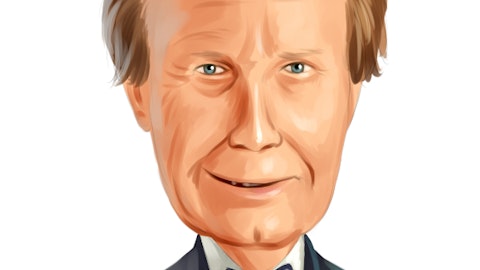Sidney Ho : Okay. That’s helpful. My follow-up question is, if I look at the first quarter, you gave some color on — in the pre-ransomware events, what you’ve guided $1 billion, down 8%, you give a little comment on semi versus electronics packaging and especially Industrials. Just on an order basis, do you expect first quarter to be the trough for any of these businesses. Maybe you can comment on the kind of backlog or what you’re seeing into second quarter Well, that would be great.
Seth Bagshaw: Yes, Sandy. So we don’t really comment on order rates, but I think that you can surmise that because we would have guided $1 billion, the strength of the backlog is really carrying that, especially for the semiconductor industry, as you mentioned. And so we’re really happy with the strength of our backlog that we would have done much better. As I said before, whatever gets lost in Q1 because of the ransomware event we expect substantially will be made up by Q2.
Operator: Our next question will come from Krish Sankar of Cowen and Company.
Krish Sankar : Drove them to first one, John, back to the prior question about pre-runs I would have guided $1 billion, thanks to the backlog. Is it fair to assume if you try to look at the linearity through the year, your revenue should eventually follow the WFE pattern. In other words, your customers are knowing their inventory in theory, semi should start slowing free progress through after Q1 pre ransomware. Is that a fair assumption?
John Lee: Yes, Chris, I think that’s a fair assumption, but I would point out, though, that because we’re exposed to 85% of WFE, as you well know, you covered these companies, not all of them are behaving the same way. Some customers of ours in wafer fab equipment are saying they’re going to go down in Q1 and — or first half and some have different rates at which they’re going to go down. Some are saying, no, it’s still pretty steady in the first half. And some of the saying is going up. for the whole year even. So we’re exposed to all those customers. So in general, you’re right, if WFE goes down, we’ll go down. Our long-term model has obviously demonstrated that we can outperform WFE by 200 basis points. But we’re a much broader company now, and we’re exposed to different parts of WFE. And so I think that just allows us to be a lot stronger supplier to the ecosystem.
Krish Sankar : Got it. And then a follow-up for Seth. You said just curious with this random impact on your revenue. How does that affect your term loan covenants?
Seth Bagshaw: Yes. As we talked about in the exit in the fourth quarter, our net leverage ratio was 3.4, gives a lot of headroom relative to a 5.25 leverage covenant ratio, which is on the term loan A only, by the way, which is where we paid off the $100 million in the fourth quarter. So that covers only tied to term loan A. That’s $90 million exiting Q4. And looking ahead, we see headroom going forward as well. So that’s an area we feel very comfortable with, quite honestly. That revenue moving from Q1, we believe entity recover in Q2 will kind of offset that on a 6-month basis. So we feel very comfortable with covenants going forward. But we’ll kind of lean into that term loan A as well. It’s kind of where we’re going to kind of delever more aggressively.




